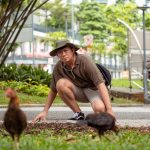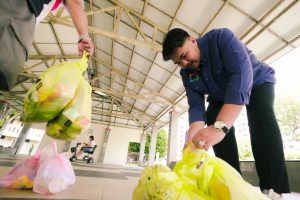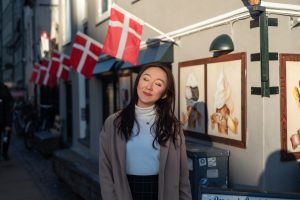All Images by Stephanie Lee for RICE Media
In August 2004, Timothy Ng and Maureen Ng, both 75 years old at present, were handed the reins of a kelong near Pulau Ubin.
The couple, both former civil servants, were looking to occupy themselves after retirement when the opportunity to buy a kelong appeared in an advertisement in The Straits Times. They paid $61,200 for the kelong and its accompanying fish farm and spent an additional $92,000 to bring the kelong to a proper “operational state”.
“I always liked the sea and thought it was a good venture. And I thought my husband needed a hobby to keep him alive after retirement,” Maureen, a former principal of National Junior College, jokes.
Timothy, a former Deputy Commissioner of the Inland Revenue of Singapore until 2008, chimes in. “I was about to retire, and the family, especially my wife, thought I should find some activity to keep me healthy.”
The kelong, an offshore platform built predominantly with wood, once dotted Singapore’s coastal waters. According to the Nature Society of Singapore, the country’s coastal waters were home to about 300 kelongs in the 1950s. Kelong numbers, however, started to dwindle in the 1960s.
Only four kelongs have survived and remain in Singapore’s waters today—near Pulau Ubin, Seletar, and Lim Chu Kang.
Singapore’s fishermen used these offshore floating platforms to catch wild fish. Those who found more solace on the waters than land occupied the kelongs and lived there with their families.
Building a kelong starts at its base. It’s a scaffolding of interconnected wooden poles, a dense matrix of wood which spikes out of the water and stretches towards the sky. A house, also built mainly out of wood, sits atop.
Out in the waters, the kelong is an unnatural sight. The sea beats ceaselessly against the poles, the wooden beams indifferent to the water’s begging currents. At first sight, this mass of wood should not be a match for the seas. And yet, the kelong stands unyielding amidst the water’s erratic nature.
The secret to a kelong’s longevity lies in the cycle of rejuvenation. Like the ship of Theseus, the kelong’s wooden panels and poles are replaced every few years, guaranteeing that it will remain in the very spot where it was built—much like Timothy and Maureen Ng’s kelong, which was built in 1972 and is now 51 years old.
Unless, of course, kelong owners choose to leave. It is, however, more likely that the pressures of modernisation will make the choice for them.
Kelongs and their owners are no strangers to this existential crisis. Unsurprisingly, Timothy and Maureen’s kelong, having reached its early 50s, must deal with the same existential midlife crisis: Its continued existence in Singapore’s waters.
In Retirement, Out on the Waters
Only three hours remain before the sun sets. The RICE team meet Timothy and Maureen to visit their kelong. The time the sun fades into the horizon is trivial for most. However, for kelong owners like Timothy and Maureen, the same boat ride in the dark is exponentially riskier than when it’s light.
Timothy sports a pair of cream bermudas and a loose dark grey shirt—one that flails in the wind, covering his lean frame. His skin is tan, presumably due to the hours he’s spent in the sun at his kelong. As the de facto tour guide, he rattles off kelong trivia as quickly as he navigates the boat out at sea.
“Now, a tonne of wood, used to replace the wooden stakes of the kelong, cost about $3,800. The most wood I’ve ever bought in one sitting is over $10,000. More than five tonnes. We replace the wood every three to five years. It depends on the wood quality we get,” he explains.
Over a strained voice, Timothy estimates that he and his wife have spent slightly over $2,000,000 on the kelong and the fish farm in the 19 years since they bought it. “We feel it’s our responsibility to maintain and preserve the kelong. It’s part of our heritage.”
Maureen jokes, “Soon, we’ll use up all our pension money.” Maureen wears comfortable walking shoes, jeans, and a simple white T-shirt. A ferocity belies her responses when asked about the kelong. She is determined to keep the kelong for as long as possible.
“I remember we stood on the platform of our kelong one evening. We looked out into the sea, and we could see all the fish moving in the water. So exciting. And we’d just hope they’d come into our nets.” Maureen continues. “It was amazing. I tell you, it was amazing. For years, I’ve not seen that now. So sad.”
Before the 2010s, the couple recalls the days when a single net raised at the kelong, floating in open waters, could easily fetch about 200 kilograms of ikan bilis at a single time (Malay for ‘anchovies’). The inflection point arrived in 2015 when a plankton bloom wiped out large fish stocks in February.
Kelong nets, which once burst at the seams with fish, are now, more sparsely laden. “We’re probably getting about 30 percent of what we used to get before the 2010s,” Timothy recalls. Their kelong’s yield has dropped considerably over the years. And it’s this lack of fish that threatens their kelong’s sustainability.
Something’s Fishy in the Waters
With a dwindling catch from kelong nets, kelong owners moved towards commercial fish farming. Timothy and Maureen did the same with their kelong. A floating fish farm sits just in front of the couple’s kelong.
The approximately 205 square metres kelong house stands on stilts, piled at least 10 metres into the seabed to keep it stable. On the other hand, their floating fish farm rises and falls with the tides. It’s an interconnected grid of squares, each square being an enclosure for fish.
The sprawling mass of wood gets larger as Timothy pulls the boat to a stop beside a wooden platform. A signal to disembark is given, and members of the RICE team take unsteady steps onto the platform. The divide between the kelong and fish farm is apparent, even to the untrained eye—a ramp, acting as a makeshift bridge, lies between them.
The sounds of modernity are nowhere to be found. The only sound reminiscent of the city is the quiet hum of a machine lifting the kelong net out of the waters.
Timothy, Maureen, and their two employees are overtaken by a sense of anticipation when a net emerges from the depths of the waters. Then, an inevitable sense of disappointment, one more palpable and distinctive in the quiet of the kelong—the net has yet to bring in a large enough catch.
Generally, kelong-fish farms, owing to their size and resources, produce smaller catches than commercial coastal fish farms. For a resource-scarce country that aims to produce 30 percent of its nutritional needs by 2030, it seems every inch of sea space occupied by fish farms must contribute to that goal in some small way.
The Singapore Food Agency (SFA) explained to RICE that seafood was identified as a priority area as it is “one of the more productive and resource-efficient food-types, a good source of protein, and suitable for land-scarce Singapore”.
Currently, kelong-fish farms do not need to pay for the use of sea space. Instead, they only pay for the yearly renewal of their fish culture farm licence. Timothy and Maureen pay slightly over $1,000 yearly for their licence renewal but not for the sea space they occupy.
But precious sea space occupied by kelongs and their accompanying fish farms could be used for commercial fish farms with larger catches. And that’s about to change.
Then-Minister of State for Sustainability and the Environment Desmond Tan announced in last year’s Budget Debate that sea spaces will be leased to fish farms soon.
It’s a 20-year lease, but fish farms can renew it for an additional 10 years if they meet “SFA’s production output conditions.” The SFA explained to RICE that the new leases offered fish farmers more “certainty on the tenure of sea spaces” in Singapore’s waters.
Demand for Singapore’s sea spaces is only growing. The Straits Times reports that the country’s waters can be used to deploy solar panels and other industrial or recreational activities. Leasing the sea spaces affords more certainty around the use of Singapore’s waters.
But Timothy and Maureen are concerned that “output conditions” will be challenging for their kelong and fish farm.
They might get the first 20 years but are concerned that they might be unable to renew the lease for the additional 10 years. What happens to Timothy and Maureen’s kelong-fish farms after 30 years, along with the others, is anyone’s guess.
Timothy and Maureen feel the squeeze of these production targets. According to the couple, they already find it challenging to maintain their yield, let alone meet production targets tied to the lease of their kelong-fish farms. Even meeting production targets comes with its own problems downstream.
And if the remaining four kelongs cannot catch more fish to meet this target, it will be yet another nail in the coffin for these offshore platforms. With new production targets on the horizon, the couple estimate they must increase their yield by another 150 to 200 percent.
“We can adopt new technology to increase our yield. But we’re not sure whether it will help to meet the production targets,” Timothy explains. “We did try our best to produce more fish. But when we grow more fish, we make bigger losses. We lost about $30,000 in the initial years trying to increase the yield.”
“Technology also has not been proven to reduce unit-production costs. The next thing is whether there’s a market for it. Even with a larger output, we compete with cheaper fish from Indonesia and Malaysia. We might not be able to sell more fish to cover larger costs. The challenge is how to achieve import substitution.”
To this, the SFA has a response: “We are aware that some farmers may find the journey towards a productive and sustainable aquaculture sector challenging. For farmers who decide to exit the industry, the Government agencies will support them through the transition.”
Indeed, Singapore’s food self-sufficiency is essential. But there are other ways to value the humble kelong, an indelible part of Singapore’s maritime heritage.
Perhaps it’s more valuable to see kelong-fish farms as living and breathing artefacts of Singapore’s past rather than merely output machines. When we group them with other commercial fish farms, we forget the importance of the kelong in Singapore’s history.
Time and Tide Waits For No One
In the comments section of RICE Media’s video about Timothy and Maureen, Singaporean Instagram users seem to agree.
“It [the kelong] should be saved and preserved for cultural purposes, and I believe that the next generation should learn about kelongs first-hand instead of from photos and videos,” one Instagram user remarks.
“We should not be building our economy at the expense of our society. A soulless society will not bring you your economic benefits anyways,” another elaborates.
Unfortunately, Singapore’s kelongs have long faced this existential crisis. In 1965, the then Primary Production Department in Singapore, the regulatory authority which oversaw the local farming and fishing industry, stopped handing out licences for new kelongs.
Kelong numbers ceased to increase. Rapid urbanisation then pressured existing kelong owners back to the mainland. A dwindling number of kelong owners eroded even further. In 2009, there were about 14 kelongs left in Singapore’s waters. One by one, they were plucked out of the sea, their aching wooden stakes erased by the tides of time.
Only two hours remain before the sun sets. Standing dangerously close to the edge of his kelong’s platform, Timothy points into the distance. A smattering of speedboats rushing across the water are seen, and beyond them, another island. “That’s Pulau Ubin. We’re about 100 metres away from it.”
“You can build a bridge to link Pulau Ubin to this kelong. Somebody can take over, and the kelong can be opened up to learning journeys for primary school children,” Maureen adds. “Our wish is for the kelong to last as long as possible. Few people talk about kelongs as part of Singapore’s heritage.”
Indeed, Singapore’s kelong industry was dominated by the Teochew community. Teochew immigrants settled in the northern areas of Singapore—mainly Punggol, Sembawang, and Upper Thomson. Always within their reach, the sea became the community’s primary focus. They survived as fishmongers, fishermen, and boatmen.
Singapore’s waters were once teeming with fishing activity—very much contradictory to the “sleepy” fishing village narrative.
In the morning, fishermen set out on the waters around the island to make their daily keep. Singapore, known as Temasek back then, thrived because of them.
If the kelong goes the way of the dodo, perhaps it’s seeing a part of Singapore’s living heritage erased. Soon, the story of the kelong will only be told in museums, exhibits, and by Singaporeans who had the privilege of experiencing one for themselves. Nothing more.
The Last Attempt to Save the Kelong
“We don’t consider the kelong an investment. It’s just putting up money to cover the expenses. Every year, it’s a loss of over $100,000,” Timothy remarks. “We earn from somewhere else just to keep the kelong going.”
“We have never made money, only just enough to keep it going. We feel it’s our responsibility. We just want the kelong to continue standing in Singapore’s waters. We talk about preserving heritage, but there’s living cultural heritage right here in the seas.”
Only one hour remains before the sun sets. The seas are calmer, and the weather is cooler. The RICE team settles into the boat. The sun begins its slow descent as the team takes off for the mainland. The first of the sun’s dying rays settle on the kelong as it blurs into the distance.
Singapore’s four kelongs continue to exist in Singapore’s waters. But their survival is not promised. The death of Singapore’s kelongs has come swiftly and silently. On the mainland, Singaporeans have nary a clue about their disappearance.
This is a fight Timothy and Maureen didn’t ask for when they bought their kelong in 2004. However, it’s a fight they have gladly taken on—to preserve the remaining vestiges of Singapore’s maritime heritage.
Before the kelong disappears entirely into the distance, Timothy and Maureen look behind, past the RICE team, and gaze upon the kelong’s vanishing silhouette. They give a final nod of acknowledgement before the boat enters open waters.
Whether the sun will set for the final time on Singapore’s kelongs, only the tides of time will tell.







